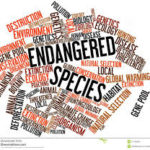 And this isn’t a case of a few misplaced animals! (has anyone seen what I did with that woodchuck?) According to the World Wildlife Federation (a fairly credible, although not unimpeachable, non-profit) and the London Zoological Society, the number of wild animals on Earth has halved in the past 40 years. Two key concepts: “50%” and “gone”. Creatures across land, rivers and the seas are being decimated as humans kill them for food in unsustainable numbers, while polluting or destroying their habitats……in just the last 4o years! In a Living Planet report posted at the WWF website, it shows the methodology by which the steep decline of animal, fish and bird numbers was calculated by analyzing 10,000 different populations, covering 3,000 species in total. This data was then, for the first time, used to create a representative “Living Planet Index” (LPI), reflecting the state of all 45,000 known vertebrates.
And this isn’t a case of a few misplaced animals! (has anyone seen what I did with that woodchuck?) According to the World Wildlife Federation (a fairly credible, although not unimpeachable, non-profit) and the London Zoological Society, the number of wild animals on Earth has halved in the past 40 years. Two key concepts: “50%” and “gone”. Creatures across land, rivers and the seas are being decimated as humans kill them for food in unsustainable numbers, while polluting or destroying their habitats……in just the last 4o years! In a Living Planet report posted at the WWF website, it shows the methodology by which the steep decline of animal, fish and bird numbers was calculated by analyzing 10,000 different populations, covering 3,000 species in total. This data was then, for the first time, used to create a representative “Living Planet Index” (LPI), reflecting the state of all 45,000 known vertebrates.
It bears repeating that this data documents the decline since just 1970, so this die-off/disappearance has occurred during most all of our lifetimes. The fastest decline among the animal populations were found in freshwater ecosystems, where numbers have plummeted by 75% since 1970. This isn’t surprising, as rivers are at the bottom of the system; whatever happens on the land, it all ends up in the rivers.
It also bears repeating that we aren’t necessarily talking about extinction of obscure or isolated species. Nor are we talking about the extinction of species that deserve extinction like hackers, cable TV companies, paparazzi, spammers and Donald Trump. No one will miss them, but the Earth will miss the animals that used to be common and but are no longer.
The number of land animals has fallen by 40% since 1970. From forest elephants in central Africa, where poaching rates now exceed birth rates, to the Hoolock gibbon in Bangladesh and European snakes like the meadow and asp vipers, destruction of habitat has seen populations tumble. Marine animal populations have also fallen by 40% overall with turtles suffering, in particular, due to hunting, the destruction of nesting grounds and getting drowned in fishing nets have seen turtle numbers fall by 80%. The biggest declines in animal numbers have occurred low-income, developing nations, while conservation efforts in rich nations have seen small improvements overall. But the big declines in wildlife in rich nations had already occurred long before the new report’s baseline year of 1970.
Oh, and these impacts are being felt here in the U.S. A recent study found that California has lost half of its big trees in the last 80 years. The primary culprit: climate change. In Southern California, the loss of big trees was closer to 75%. Because projections for California over the next 100 years suggest a continuing increase in average temperature, scientists expect that California forests will continue to lose its big trees.
This report is sobering……….and it isn’t just an environmental issue. It will affect consumers as well. As ecosystems collapse, the cost of food or any goods made from animals will become more expensive. In particular, the loss of freshwater species will have substantial impacts upon agriculture. And because this collapse is more pervasive in developing countries, they will need to import food from Western countries, thus contributing to higher prices for us at home. This kind of dramatic change, much like the honeybee colony collapse that began in 2006 impacted the price of almonds, apples, blueberries and citrus.
We have just one question for those brave enough to have read this far. If your neighbors or local authorities reported to you that half of all dogs and cats in your area had disappeared, how would you react. If you had two pets and you knew one was going to be lost imminently, would you care? While we may not have a direct relationship with dolphins, turtles, wolves or crayfish, like we have with dogs or cats, the halving of their population in 40 short years should alarm you. And, if you share your alarm, it may be worth getting to know a bit more about efforts being made to reverse these declines. For more of this kind of information, just check out:
https://www.aza.org/conservation/
http://www.endextinction.org/#
https://www.worldwildlife.org/initiatives
And most importantly…….care.
